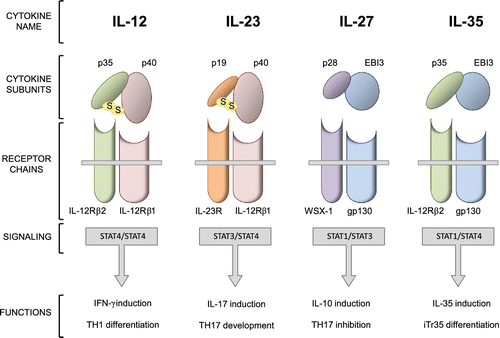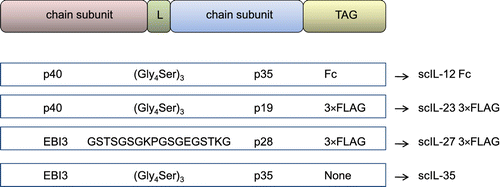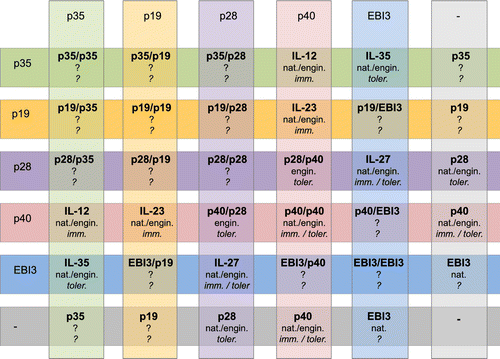Figures & data
Figure 1 Heterodimeric cytokines belonging to IL-12 family: structural and functional characteristics.Naturally occurring IL-12, IL-23, IL-27, and IL-35 are heterodimeric cytokines with a high sharing rate. The p40 β-chain is shared by IL-12 and IL-23, EBI3 β-chain is shared by IL-27 and IL-35, p35 α-chain is shared by IL-12 and IL-35, whereas IL-23 and IL-27 have unique α-chains, p19 and p28, respectively. Only IL-12 and IL-23 are disulfide-linked heterodimers. The receptor complexes of heterodimeric cytokines also include shared subunits; IL-12Rβ1 is present in receptors for IL-12 and IL-23, IL-12Rβ2 in those for IL-12 and IL35, and gp130 is common to IL-27 and IL35 receptor complexes. Jak-STAT signaling partners of these receptors are indicated, as well as the functional effects of related cytokines.

Figure 2 General architecture of constructs encoding for engineered single-chain cytokines of the IL-12 family.Schematic diagrams of the DNA constructs for single-chain IL-12, IL-23, IL-27, and IL-35 fusion proteins are reported, showing that the β chain (p40 and EBI3 subunits) and the α chain (p35, p19 and p28 subunits) can be sequentially and genetically fused with a DNA linker (L). Resulting constructs can be further fused with an appropriate tag sequence (mainly consisting of Fc of IgG and 3×FLAG).

Figure 3 Schematic diagram of all possible combinations for IL-12 family subunits.The diagram shows that the combination of five types of subunits belonging to the IL-12 family may lead to ten heterodimeric and five homodimeric distinct proteins, in addition to five monomers. Of these, the natural (nat.) existence of only four heterodimers (IL-12, IL-23, IL-27, and IL-35), one homodimer (p402), and three monomers (p40, EBI3 and p28) is known, whereas only one engineered (engin.) combination (p28/p40) has been generated so far. Where identified, immunological functions – either immunostimulatory (imm.) or tolerogenic (toler.), or both – are indicated.
